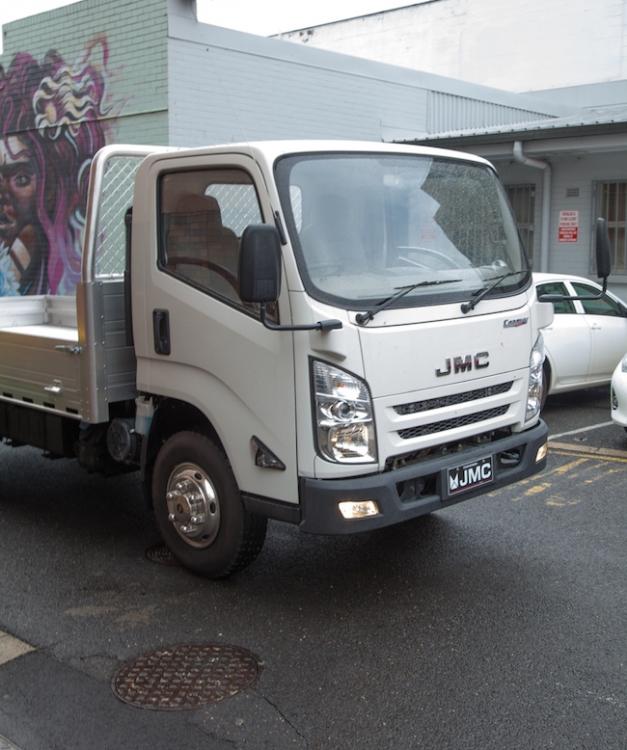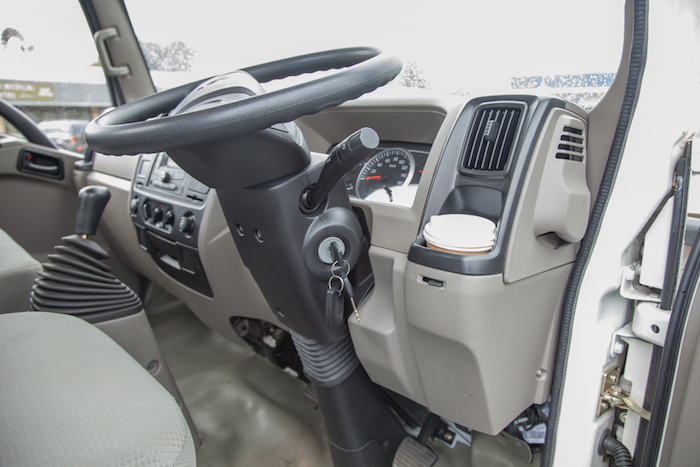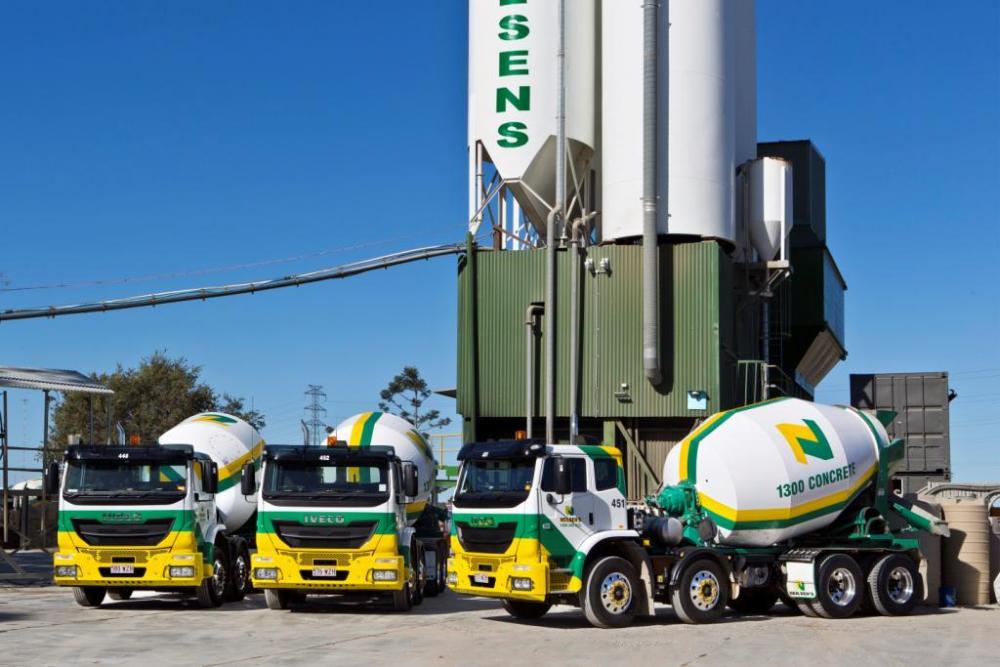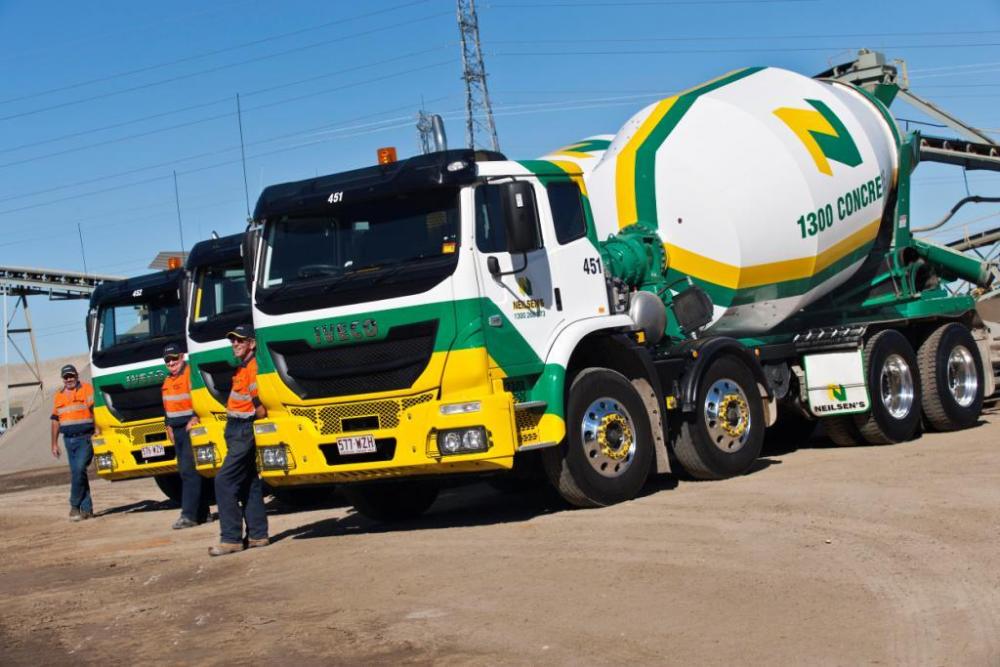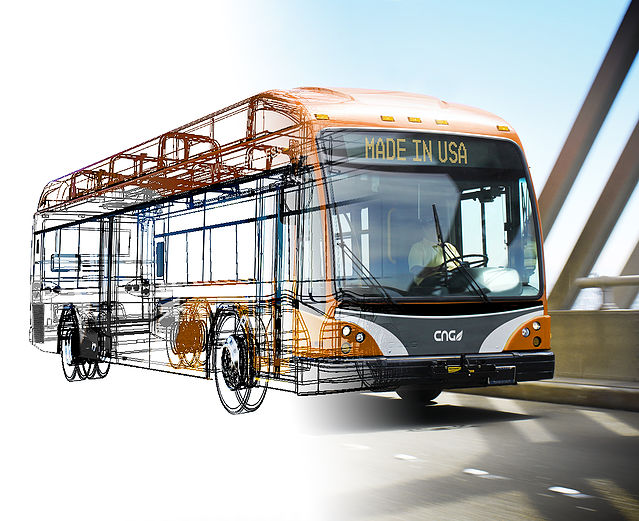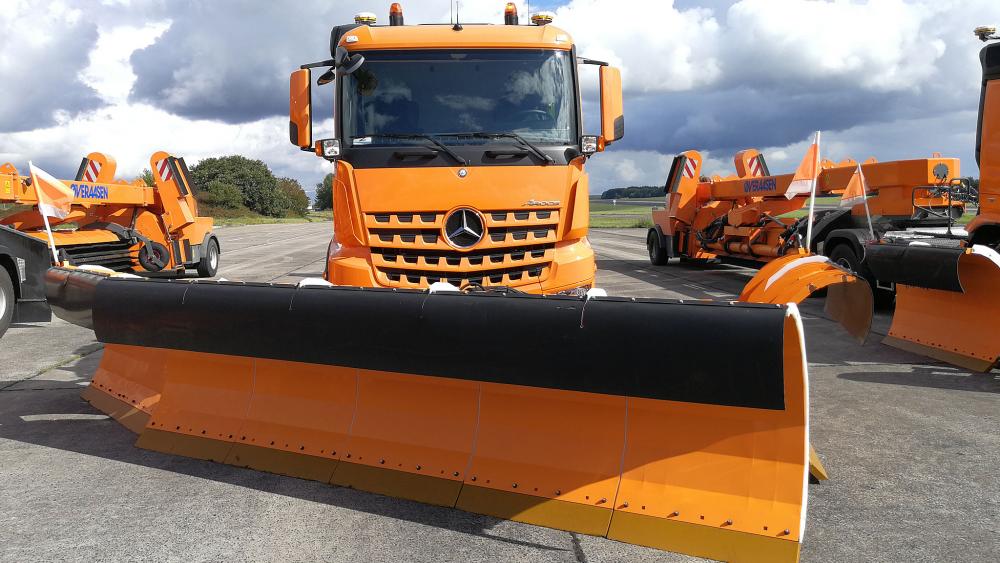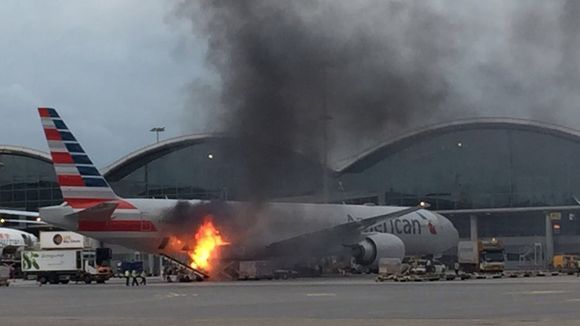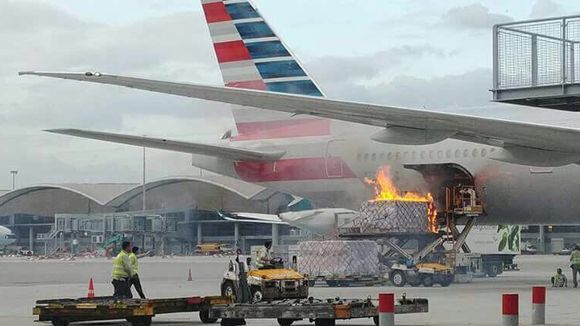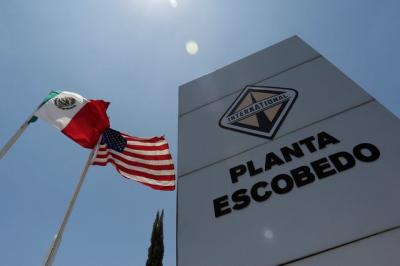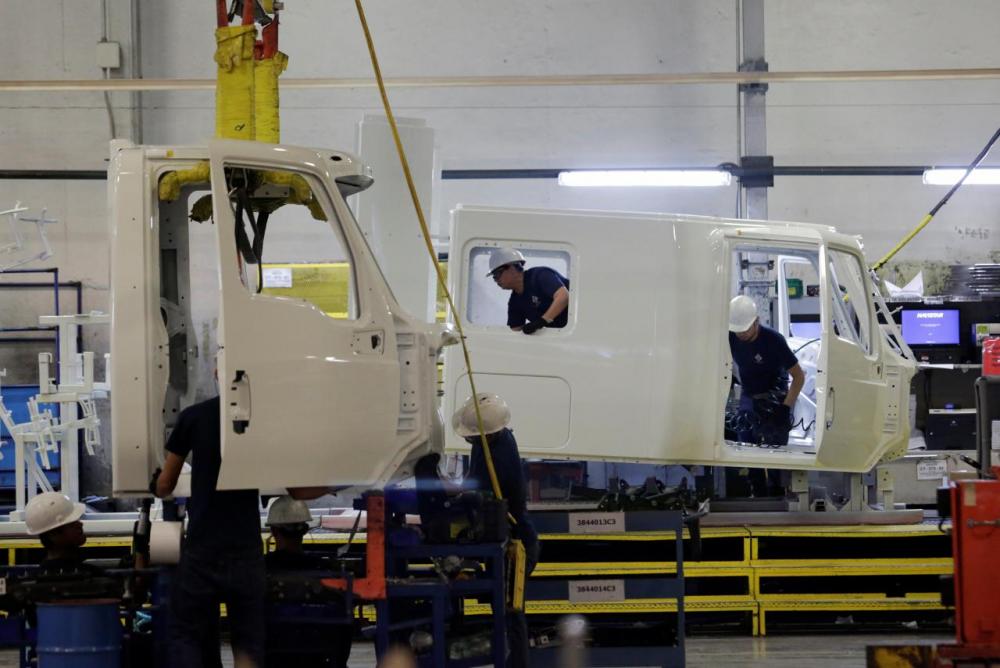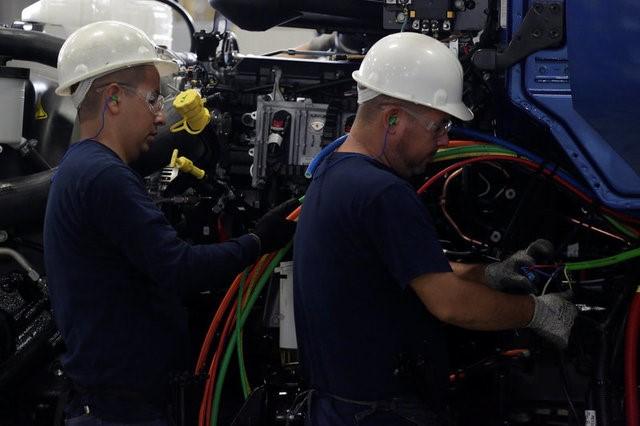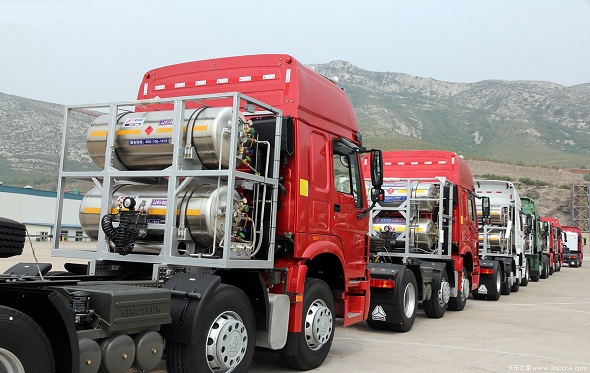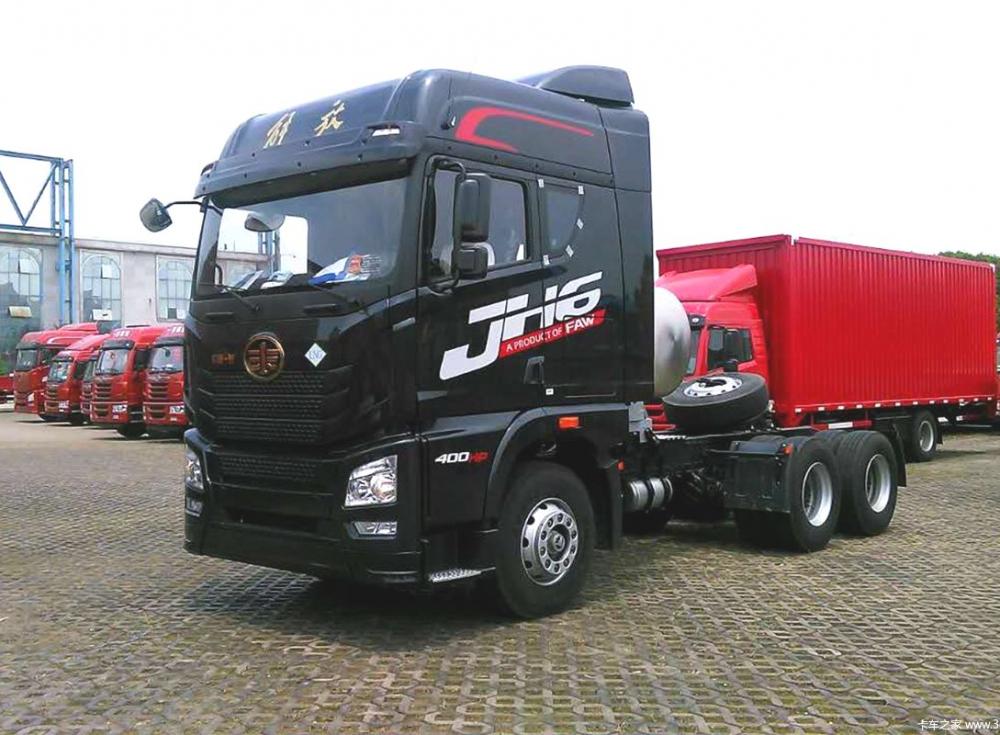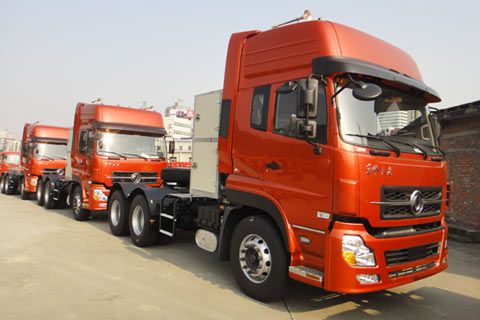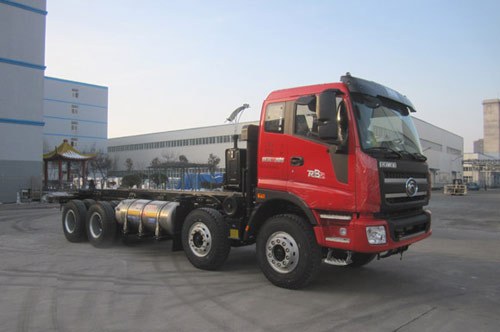
kscarbel2
Moderator-
Posts
18,886 -
Joined
-
Days Won
114
Content Type
Profiles
Forums
Gallery
Events
Blogs
BMT Wiki
Collections
Store
Everything posted by kscarbel2
-
Diesel News AU / October 2017 There is always room for another Chinese contender in the Australian truck market – the latest is JMC. We already have close to twenty different truck brands competing in the Australian market, so why not add one more? Diesel News reported on the launch of the new brand from China, JMC, late last year. Now the company has trucks on the streets and is ready to start selling product. The company behind the brand is the Jiangling Motors Group, an operation that built its first vehicles back in 1968. Over the years it has branched out from cars into commercial vehicles. A joint venture with Ford saw the company building Transit vans in China and a deal with Isuzu led to the production of N Series cabs and some truck assembly work. Now, the company is building its own brand truck and opening up markets around the world. The JMC Conquer is a familiar-enough-looking truck. It appears to be based on the Isuzu N Series, not surprising after JMC’s previous cooperation with the Japanese truck maker. The cab is clearly closely related to the current generation of the Isuzu cab. The three-litre Topanther TDCi engine is also either an Isuzu or very closely related to the one fitted to the lightest end of the N Series range, the 4HK1-TCN. Sitting in the engine compartment, the engines look very similar plus the power and torque ratings, and rpm levels, are exactly the same. There is one major difference, however, it uses SCR to clean up the exhaust emissions and meet ADR 80/03. The truck tested by Diesel is the JMC Conquer 3360. The numbers refer to the wheelbase length, at 3,360mm. Dimensions and specifications are comparable to a truck like the Isuzu NLR medium wheelbase. Walking over to the truck, it looks like just another Japanese truck off the production line. Most passers by would think it was an Isuzu or just a generic white small truck. For those with a bit more knowledge of the sector, the mirrors are the giveaway, apart from the badge on the front, of course! These mirrors are fitted on the front corner of the truck and not on the door. The driver has to look through the windscreen to see down the nearside of the truck, this is a typical domestic configuration in much of Asia. Climbing into the truck the other signs to tell us this is a Chinese truck, to look for are the fit and finish inside the cab. Here the JMC does pretty well, the floor covering seems to fit about right, door handles and step are in the right position and stable, plus the dash seems to be fitted securely. In fact, the first impressions are good. The truck is well finished and surprisingly sound. The door closed with the right noise. The key goes into the ignition and the engine starts with a familiar sound and runs evenly. Setting off is as one would expect in any small truck, and the feel is quite positive. Chinese trucks of the past have suffered with badly set up steering, braking and clutches, there is none of that here. The steering is direct, positive and easy, just as it should be when running around town and the turning circle is excellent. Braking is effective and well adjusted to feel safe for the driver and not snatch when activated. Similarly, the clutch has the right feel and bites at the right moment. All good so far. In fact, this truck does not take any getting used to. If the driver has had a go with a small Isuzu, Hino or Fuso, they will know exactly where they are, driving this truck. Controls are in the right place and things like pulling on the exhaust brake have the same effect as they do on other trucks, largely ineffective. If there is one difference it is in the sound of the braking system. Most trucks this size use some form of hydraulic/vacuum arrangement to control braking. This particular JMC model uses air brakes and driving with the window down, the driver hears a nostalgic sighing sound from the brake booster, reminiscent of the eighties. Changing gear is simple enough. The six speed box has a low first ratio, so setting off in second is the norm. The default position for the gear stick is quite central, to engage second, when starting off, the driver has to push the stick to the left and forward. The driver gets used to this in no time. If anything the action on the gear stick is just a little notchy, but this truck has only done a few hundred kilometres and can be expected to improve after a while. .
-
NTI restores International truck to raise funds for charity
kscarbel2 replied to kscarbel2's topic in Trucking News
Green Diamond – Final Chapter Diesel News AU / October 2017 It’s all over, we are now at the Green Diamond – Final Chapter stage and the 1946 International K5 has found a new home. Powered by a ‘Green Diamond’ 233 cubic-inch side-valve six-cylinder petrol engine, the truck was originally owned by H & L Hamilton at Miles and is now in the possession of the lucky ticket holder. On 1 September, the Green Diamond was ready to show its true colours to the eagerly waiting public at King George Square in Brisbane. All up, $55,020 was raised from raffle ticket sales, with all proceeds going to the MND & Me Foundation. With Brisbane radio station Triple M’s Greg ‘Marto’ Martin as host, there was only one thing left to do and that was reveal the winner of the amazing Green Diamond. Trevor Fry, a Queenslander, was revealed to be as the person fortunate enough to be driving away in the classic truck. Two runners-up, Leonie Roberts and Wayne Wust, each walked away with a $2,000 BP fuel voucher. It was a fitting conclusion to a collective labour of love that spanned more than six months and saw a rusting relic transformed into an object of class and beauty. Congratulations on a job well done to all involved – it truly was a monumental effort. -
NTI restores International truck to raise funds for charity
kscarbel2 replied to kscarbel2's topic in Trucking News
. -
IVECO Trucks Australia / October 9, 2017 As South East Queensland’s largest independent supplier of premixed concrete and quarry products, the Neilsen Group works hard to meet the needs of its growing customer base, so when six new agitators were needed fast, it turned to IVECO to deliver with its proven ACCO 8x4. Being locally manufactured in Melbourne, lead times on ACCO models are much shorter compared to its imported competitors, meaning trucks can be put to work faster even when larger numbers are required. Despite the ACCO being a concrete industry icon with class-leading tare weight, Neilsen Group Transport Manager, Bevan Richardson, said the company had not operated ACCOs until now. “This is the first time as a company that we’ve added ACCOs to the fleet, and although it’s early days they’ve been great and haven’t missed a beat,” Bevan said. “We purchased five as a company and a sixth was bought by one of our subcontractors – we needed the trucks promptly to meet the requirements of a contract and IVECO was able to work with our tight schedule to get them on the road fast.” All six trucks are fitted with ATT eight cubic metre bowls and feature familiar industry-standard American driveline components including Cummins engine and Allison 6-speed auto transmission. The trucks also ride on front and rear airbag suspension, and keeping the eight wheelers firmly planted to the road is standard electronic stability control, vital safety feature in higher centre of gravity applications. The new ACCOs are part of a fleet of around 50 trucks, mainly comprising of agitators but also including several tippers and tankers. Prior to starting work, each vehicle is put through the company’s own pre-delivery process to ensure 100 per cent reliability from day one, according to Bevan. “The trucks need to perform from the outset, we can’t afford to let down customers through mechanical issues,” Bevan said. “We have a technician that goes through each truck and checks everything, it gives us extra peace of mind.” Similarly, when it’s time for servicing, the more streamlined the process and lower the downtime for each truck, the better for productivity according to Bevan, that’s why parts availability was another important consideration when choosing ACCO. “I did the research and I know that ACCO parts are widely available all around Australia, and importantly for us, in Queensland,” he said. “It’s no good to us having parts in New South Wales or Victoria, we need to have access to a good stock holding closer to home and I know that there are plenty of ACCO parts near us and available off the shelf.” And it’s a good thing too, so long as the trucks are performing well, the Neilsen Group tends to keep its trucks on the road for the longer term. “We have trucks on fleet that are 15 years old, we look after them well, we have a refurbishment process and they last,” Bevan said. “It’s a philosophy that suits us well and will be a good fit for the ACCOs given they already have a great reputation for longevity and that they’re extremely serviceable.” The new ACCOs are based at the company’s sites in Brendale and Carole Park and have made a good impressions since starting work with Neilsen Concrete several months ago. “So far driver acceptance of the ACCOs has been good, they’ve been reliable and the payload is what we need – the trucks are ticking all the boxes for us,” Bevan said. .
-
UD Trucks Australia Press Release / October 9, 2017 UD Trucks New Quon is set to redefine the Japanese truck market in Australia, with features that have never before been seen in this heavy duty sector. Key features include improved safety such as disc brakes, pPNLT emissions compliant and smart drivability. .
-
Scania Group Press Release / October 9, 2017 Travelling with a container load from the Faroese capital of Torshavn out to the surrounding Faroe Islands is something that driver Lassin Weihe has been doing for more than 20 years. But these days it is with a new sense of pride that he skillfully manoeuvres his truck through the breathtaking landscape, characterised by steep cliffs, tall mountains, deep valleys and narrow fjords. Now he does the drive in a brand-new Scania S 730. Weihe, a Faroese native, has lived his entire life on this far-flung island archipelago, which lies in the North Atlantic Ocean, halfway between Scotland and Iceland. At the age of 15, he followed the age-old tradition of enlisting for the arduous work on board a fishing trawler. After four years at sea, he returned to dry land and started driving trucks. Throughout the intervening years he has driven for Faroe Ship, the leading shipping and logistics company on the Faroe Islands. The company, founded back in 1919, has terminals and warehouses on several islands and also owns the country’s largest fleet with 27 trucks for domestic transportation. New generation Scania Faroe Ship handles the majority of the seaborne exports from the Faroe Islands, most of which is fresh, frozen and dried fish and seafood. As a subsidiary of Icelandic company Eimskip, it carries goods to and from the Eimskip vessels that call at Faroese ports several times a week. Formally a self-governing nation within Denmark, the Faroe Islands are not part of the European Union and as such have their own laws, which means the obligatory EU cap on driving times does not apply. Those regulations are irrelevant anyway, since the maximum driving distance is 1.5 hours, including loading and unloading at each end as well as a friendly chat and a cup of coffee. “I do 6–7 round trips per day but I rarely work weekends. I really enjoy work except for an occasional day during winter, but that’s something you need to accept.” Faroe Ship has a mixed-brand fleet but as soon as Fleet Manager Johann Behrens set eyes on the new generation Scania, he was convinced. “I used to be a service technician and with that background I insisted that our new truck should be a Scania.” And when the choice was made, why not go for the very best? “This is an incredible truck” Some might question why the flagship S 730 is needed for the relatively short runs between the islands. Weihe dismisses all objections and knows better than most why the power is needed on the undulating Faroese roads, punctuated by steep climbs and descents. “Lately, we haven’t had much snow here but heavy winds and storms are common. Occasionally, we have to park and wait for the winds to subside. Otherwise, we might get in real trouble.” Perhaps a greater peril on the roads is the 70,000 sheep that roam nearly everywhere, outnumbering the Faroe Islands’ human population by 20,000. Although drivers are wary, collisions are not uncommon, but they are expediently settled with the payment of 3,000 Danish krone or 400 Euros. “What’s worse is that they damage the bumper, which costs much more,” says Suni Hansen, Faroe Ship’s Driving Coordinator. Meanwhile, Weihe climbs the four steps to the tall S-series cab. “This is an incredible truck. It’s difficult to fault; the truck as a whole with the handling, the comfort, well… everything makes this a great vehicle.” .
-
The US Postal Service Is Building a Self-Driving Mail Truck Wired / October 9, 2017 Neither snow nor rain nor heat nor gloom of night stays these couriers from the swift completion of their appointed rounds—and if the United States Postal Service has its way, the robots won't stop them, either. Yes, the agency you know best for bringing you junk mail addressed to whomever lived in your apartment before you has caught robofever. It plans to put semi-autonomous mail trucks into service in just seven years, and it seems to think it can pull off a shift away from human driving without shedding mail carrier jobs. That's all according to the postal service's Office of the Inspector General, which oversees the agency and last week released a report on its plans to work autonomy into its 228,000-vehicle fleet. Those plans are already in motion: The post office has partnered with the University of Michigan to build what it’s calling an Autonomous Rural Delivery Vehicle, which it wants to launch on 28,000 rural routes nationwide as early as 2025. In this vision, the postal worker sits behind the wheel but lets the truck do the driving, sorting mail and stuffing letters and packages into mail boxes while rolling down the street. Eliminating the need to constantly park the vehicle, get out, then get back in and get back to driving would yield, the report says, “small but cumulatively significant time savings.” This being a semi-autonomous mail truck, the driver would have to be ready to take over control at all times. In the beginning, researchers say, this will be especially important while navigating from the post office to the beginning of the postal route, and while navigating intersections. The postal service reasons the experimentation is less risky on rural routes, which have less traffic and fewer pedestrians and cyclists, “and are therefore more forgiving of an imperfect AV model.” It’s exactly the reason vehicle tech developers like Tesla and Cadillac have released semi-autonomous features for highway-only driving. With wide, open, well-marked roads, it’s a much less complicated environment for a robot to navigate. According to the report, Michigan researchers will deliver their first semi-autonomous delivery truck prototype in December of this year. If all goes according to plan, the USPS will pilot 10 prototypes on rural routes in 2019, leading up to that full-scale, countrywide rural deployment between 2022 and 2025. The mail people also say they plan to look into city deliveries and building fully driverless vehicles, the kind that don't need steering wheels or pedals. You’ve Got Self-Driving Mail One reason the postal service wants robocars? They could help solve its money problems. The agency lost $5.6 billion last year, mostly because Congress demands it shell out prefunded retiree health care benefits. (The idea here is that all employees’ health care will be completely paid for by the time they retire. No other agency operates this way.) The report's authors insist they're not looking to dump human workers, and that AVs can help by trimming other costs. The agency paid about $67 million in repair and tort costs associated with vehicle crashes last year. It also shelled out $570 million for diesel fuel. If the robots perform as promised, making driving much safer and more efficient, those costs could plummet. If the USPS sticks with this plan, the jobs of the nation's 310,000 mail carriers could change, for better or worse. Once the vehicles do all the driving, the humans will be left with the sorting and the intricacies of the delivery process. Unless, of course, a robot can figure out how to do those too. And whatever the report says about protecting jobs, it's clear that the best way to cut down on employee health care costs is to cut down on employees. The Postal Service says it plans to sit down with unions to discuss the implications of this tech after the University of Michigan delivers its prototype in December. (Those unions, the National Association of Letter Carriers and the National Rural Letter Carriers Association did not immediately respond to a request for comment.) But maybe the best reason for USPS to experiment with autonomous vehicles is to keep up with the Joneses. FedEx is investing in small autonomous vehicles that could make deliveries without the aid of human drivers. Amazon has an entire team dedicated to researching how autonomous vehicles (and drones) could transport its goods directly to customers. Google holds patents on unmanned truck delivery. DHL has posited driverless vehicles could be endlessly useful in warehousing operations, last-mile deliveries, and logistics operations. UPS has a test truck that shoots drones. Which gets us back to one final idea floated by the USPS Office of the Inspector General in the report. Mail carriers drive the same exact routes almost every day. If the service kits out its vans with the right sorts of sensors, those vans could build and constantly update the incredibly detailed 3-D maps that help self-driving cars navigate—for a price, of course. Yeah, other startups and companies have been built expressly to collect and mine mapping data—but don’t count out the letter carriers. If rain and hail can't stop them, why should the future?
-
Commercial Carrier Journal (CCJ) / October 9, 2017 Given that the California Air Resources Board recently awarded its lowest emissions score ever to a natural gas-powered vehicle — and not an electric vehicle — it’s odd that the state and its strict emissions regulators recently indicated a plan to follow China’s footsteps in phasing out entirely the internal combustion engine. Governor Jerry Brown is behind the push, according to CARB chair Mary Nichols. “I’ve gotten messages from the governor asking, ‘Why haven’t we done something already?’” Nichols told Bloomberg.com, referring to China’s planned phase-out of fossil-fuel vehicle sales. “The governor has certainly indicated an interest in why China can do this and not California.” Tom Quimby, editor of CCJ sister publication Hard Working Trucks, takes CARB to task on the subject in a recent blog post. He notes that CARB’s lowest emissions score ever went to a renewable natural gas vehicle produced by AMP Americas at its Fair Oaks Farm in Indiana. AMP’s -255 carbon intensity (CI) score easily beat diesel (98 CI), traditional natural gas (79 CI) and California electric (35). “It’s no secret that California has been going its own way on emissions and other big issues. That’s not the point here. The point is that the internal combustion engine, by CARB’s own admission, is far superior to that of an electric powertrain in terms of its carbon intensity score,” Quimby writes. Despite CARB’s admission, Quimby writes, the state still has a “narrow fixation on electric and hydrogen fuel cell vehicles” — an error in judgment by California’s powerful ARB, says Quimby.
-
Matt Cole, Commercial Carrier Journal (CCJ) / October 9, 2017 A recent recall affecting certain Dana Spicer D- and E-Series steer axles has prompted Navistar and Paccar to recall nearly 19,000 combined trucks. Volvo, Mack and Autocar already recalled more than 1,000 trucks due to the steer axle issue. According to National Highway Traffic Safety Administration documents, the castellated nut on the steer axles may not be properly torqued, allowing the tie rod to loosen. If the tie rod loosens, it can disconnect from the steering knuckle, causing a complete loss of steering in the trucks. The recall affects trucks equipped with certain Dana D-Series and E-Series steer axles. NHTSA documents state that drivers of affected trucks would notice an audible noise and looseness in steering before the tie rod fully disconnects. The recall issued by Paccar includes approximately 17,737 model year 2016 Peterbilt and Kenworth trucks in most models. Affected Kenworth models include: K170, T170, T270, T370, T440, T470, T660, T680, T800, T880 and W900. Peterbilt trucks affected by the recall include the following models: 220, 320, 325, 330, 337, 348, 365, 367, 382, 384, 389, 389G, 567, 579 and 587. Paccar clarifies that only approximately 2 percent of trucks included in the recall are actually affected, however, the company has to check all of the Dana steer axles for improperly torqued nuts. Paccar will begin notifying truck owners on Nov. 10. Affected truck owners can contact Peterbilt customer service at 1-940-591-4000 and Kenworth customer service at 1-425-828-5000 with recall number P817-C. NHTSA’s recall number is 17V-593. Navistar is also recalling approximately 1,175 model year 2016 trucks. Affected models include: 9900i, DuraStar, LoneStar, ProStar, TerraStar, TranStar and WorkStar. The company will begin notifying owners on Nov. 17. Owners can contact Navistar customer service at 1-331-332-1590 with recall number 17507. NHTSA’s recall number is 17V-575.
-
- 1
-

-
Green Car Congress / October 9, 2017 At the APTA public transportation show in Atlanta, GILLIG LLC a leading manufacturer of heavy-duty transit buses, and Cummins Inc. announced a technical collaboration focused on integrating and optimizing new battery electric technology from Cummins that will soon power GILLIG electric transit buses. At APTA, Cummins is introducing new powertrain configurable for either a full battery electric vehicle (BEV) or a range extended electric vehicle (REEV) incorporating a compact engine-generator. (Earlier post.) Initial development work will focus on a new battery electric GILLIG bus with a 200-mile operating range on a single charge. The bus will feature a direct-drive traction motor with peak torque of 3500 N·m (2,582 lb-ft), and utilize energy recovered from a regenerative braking system. A package of e-accessories will be powered by the Cummins system. The initial bus deployment will use a plug-in charger. The Cummins electrified powertrain on show here at APTA represents a major leap forward for the industry, and we are delighted that GILLIG will have first access to this important zero-emissions technology. The partnership enables a close technical collaboration so we can accelerate system integration and performance optimization work to leap ahead of others in the industry. Beyond the technical development work, the partnership will also encompass the full range of 24/7 service support, diagnostics, over-the-air connectivity, flexible warranty plans and training programs ready for when these GILLIG electric buses enter service. —Amy Boerger, Cummins Vice President — Sales North America Cummins currently powers the GILLIG series of Low Floor, BRT, BRTPlus, Commuter and Trolley buses with a broad portfolio of diesel, near-zero natural gas and diesel-hybrid power systems. The addition of Cummins electrified power systems to the bus range will align with transit customers looking to introduce zero-emissions buses to their fleets while still maintaining commonality with their existing GILLIG vehicles and service support provision. .
-
BYD raises capacity, adds new electric models at California bus plant Automotive News / October 10, 2017 BYD Co. has hiked the annual production capacity at a California electric bus assembly plant to 1,500 units -- up from 300 previously -- to meet growing demand in North America. The latest expansion will allow the factory to build electric trucks and special purpose vehicles, as well as buses. The addition of a new wing has nearly quadrupled the plant’s floor space to 450,000 square feet. The factory now employs 800 workers, up from 300, with plans to hire 400 more. The Lancaster, Calif., plant, which opened in 2013, is BYD's first overseas EV assembly plant. It has delivered 137 electric buses in the United States and Canada. Deliveries this year total 75 buses, and customers have ordered 300 more. BYD assembles buses and other EVs in China, California, Scotland and Brazil, and is building plants in Hungary, France and Ecuador. BYD, based in the south China city of Shenzhen, is listed in Hong Kong and Shanghai. It is partly owned by U.S. billionaire Warren Buffett.
-
The Financial Times / October 9, 2017 Daimler Trucks is aiming to get ahead of rivals in the shift to mobility services with a simplified, self-driving fleet of lorries that can remove snow at airports and make it safe for aircraft to land. The 25-tonne, bright orange lorries are unique in the world of self-driving vehicles because they are automated rather than autonomous. This means they take a predefined route rather than making split-second decisions on direction through the use of sensors. “We don’t need artificial intelligence, we don’t need the latest technology,” said Philipp Dreyer, who heads the project. “It’s not so much autonomous in the sense of watching the surroundings and making decisions, it’s more a predefined lane that is basically stored, digitally, in the vehicle.” The technology is deliberately simpler than more sophisticated vehicles, such as the Google Waymo car with its built-in cameras, to keep costs low and make the project viable before others in 2019. The project underscores that big developments in driverless vehicles are likely to come from the transportation sector itself, rather than consumers who want the convenience of a car that navigates a city on its own. “The first movers won’t be the consumer,” said David Park, vice-president of marketing at Optimal Plus, a big data analytics company. “It’s the trucking industry, the taxi industry. They want the efficiencies and scale of continuous driving. These are industries where time, literally, is money.” In a demonstration of the technology at a private airport 90 minutes outside of Frankfurt, an operator sitting in the driver’s seat of the four-lorry convoy’s lead vehicle typed in a few commands. The lorry accelerated, turned on to the runway and began to travel at 30km an hour. Three identical, unoccupied lorries made the same moves at a safe distance behind the lead vehicle, then shifted into a staggered formation and dropped high-speed snow-clearing brushes on to the pavement in a simulation of clearing the snow away. Daimler can set the parameters within an inch of where the vehicles should drive. The project was commissioned by Frankfurt Airport, whose “winter services” of de-icing aircraft and clearing runways will cost €23m this year. The trouble is, the airport must have specialist drivers at the ready even when it does not snow. So it tasked Daimler with creating a driverless platoon that could carry out the mission, 24 hours a day. For Daimler, the challenge was an opportunity to move from selling a product to creating a solution tailor-made for a customer. The company said 40 airports of similar size around the world would be potential customers. .
-
A fluke, or an improvised explosive device (IED) that went off prematurely. ----------------------------------------------------------------- Raging inferno beside American Airlines plane spooks passengers RT / October 9, 2017 Dramatic footage of a raging inferno breaking out next to the terminal at Hong Kong’s Chek Lap Kok international airport as cargo was being loaded onto an American Airlines Boeing 777 aircraft has emerged. Passengers are seen looking on in horror as flames appear on one side of the plane. The fire broke out at approximately 5:30pm local time on Monday. The cargo loader itself reportedly caught fire, which in turn spread to the container it was placing on board the aircraft. The fire did not actually spread to the plane, however. When a loading vehicle was loading cargo onto the plane it caught on fire,” a police spokesperson said, as cited by the AFP. The loader operator sustained minor injuries according to an American Airlines spokesperson Martha Thomas, as cited by USA Today. Thomas said that despite the lack of damage to the aircraft itself, the flight was cancelled “out of an abundance of caution.” All affected passengers have already been booked on alternate flights. . .
-
Reuters / October 9, 2017 Less than half the trucks exported from Navistar’s mammoth Escobedo plant in Mexico are sold in North America but the factory’s success remains tightly tied to the uncertain future of the region’s NAFTA free trade deal. Navistar’s Mexican factory, now the U.S. company’s largest worldwide, exports to around 30 countries and sells less to the United States than competitors such as Daimler AG, one of the top three truck-makers in Mexico, which sends three-quarters of its Mexican-made commercial vehicles north. But Navistar’s reliance on tariff-free imported parts shows why even Mexico manufacturers that have diversified their customer base away from the United States still fear U.S. President Donald Trump’s threats to scrap NAFTA. “To lose this treaty would be to go backwards 40 years,” said Oscar Ruiz, operations director at the plant, fearing a return to an era when barriers made foreign investment and trade expensive between the two neighbors. Trade negotiators from the United States, Mexico and Canada will meet this week in Washington for a fourth round of talks on reworking NAFTA amid growing signs of an impasse between the Trump administration and the other two signatories of the pact. Mexican officials warn that Trump is leading the region towards a protectionist trade war with his “America First” policy, flirting with major curbs on commerce. Nowadays, over half the original parts for the vehicles made at Navistar’s 250 acre (100 hectare) site in the northern state of Nuevo Leon arrive duty-free from the United States and Canada in hundreds of trailers every day, Ruiz said. Higher tariffs on imports or reduced trade flows would raise the cost of production and of exporting to the United States. That would make trucks more expensive for all Navistar’s customers, experts consulted by Reuters said. Navistar, for example, uses Alabama-made Cummins engines in its International Prostar and LT heavy tractors. Without NAFTA, importing the engines would likely cost 10 percent more, based on World Trade Organization tariffs, according to Manuel Nieblas, a manufacturing consultant at Deloitte Mexico. With engines representing up to 45 percent of the $130,000 cost of a Prostar truck, that tariff alone could add around $5,800 to the final price. Prices would also rise for most of the up-to 12,000 parts used in a Navistar truck, both due to the tariffs and slower border-customs checks if trade were to be more regulated. A ‘LOGISTIC SPRINGBOARD’ Aside from higher prices for imported parts, ending NAFTA would likely impose a 4 percent tariff on top of the total value of the Class 8 truck 18-wheeler for export to the United States. Still, that might be slight enough for U.S. consumers to absorb, or for the company to shave off its margins. And Navistar’s strategy of using Mexico’s low costs and multiple free trade deals to export to markets from Saudi Arabia to Australia could soften the blow of any tougher export rules for the United States, Mexican Chief Executive Carlos Pardo said. “More than ever I believe Mexico is a logistic springboard, where on top of a qualified work force and reasonable production costs, logistically it has created the connections to supply any part of the world,” Pardo said in Navistar’s Mexico City headquarters. While 98 percent of trucks exported from Mexico go to the United States or Canada, U.S. truckmaker Kenworth, China’s Giant and Korean automaker Kia all have a similar strategy of building in Mexico to export to countries other than the United States. Scrapping NAFTA might not hurt exports to robust European economies, but those to Latin America, Navistar’s top market after North America, would become much more complicated, said Salvador Pasquel, an automotive expert at Baker McKenzie. Business with Colombia, which in 2011 was the biggest market in Latin America for U.S. truck companies after Mexico, helps illustrate what could happen if NAFTA collapses. Sales plummeted after vehicles got more expensive because of changes in Colombia’s trade policy, including a tax of 15 percent on the value of new imported heavy trucks. “We went from exporting $817 million in heavy tractors in 2011 to barely $1 million in 2015,” said Miguel Elizalde, president of Mexico’s truck and bus business chamber, Anpact. One fear for Mexico-based companies is that increased costs there would boost Latin American sales of trucks made in Brazil, whose vehicle industry belongs to the Mercosur free trade bloc. “If it’s harder for Mexico to place its products in Latin America, the big economy that could provide those cars and trucks would surely be Brazil,” said Baker McKenzie’s Pasquel. The worries over NAFTA coincide with a recovery in Navistar’s U.S. market. After a long stretch of depressed sales, orders for Class 8 trucks in the United States soared for the fourth consecutive month in September, according to preliminary data from industry forecaster FTR. (here) Analysts expect a strong year in 2018. Although Lisle, Illinois-based Navistar posted a second quarter loss, its share price has recovered lately as the company turns itself around after a disastrous bet on a costly and unsuccessful smog-reduction system. Last year, Volkswagen’s truck unit said it was buying a stake in Navistar as part of an alliance in which the two companies will share technology. In Mexico, growth of truck-making under NAFTA has been rapid. In 1993, a year before the deal took effect, Mexico exported 1,040 heavy vehicles. Last year, it sold 106,161 such vehicles abroad, according to Anpact figures. Navistar’s Escobedo plant was producing three vehicles a day when it opened in 1998. It now makes 160, with capacity for almost double that, factory manager Ruiz said. The company is under no illusion it could maintain those volumes without NAFTA, though the plant recently decided to hire 150 new workers because of recovering U.S. demand. “We could survive, yes, but the question is, at what level?” Ruiz said. .
-
Cummins Press Release / October 4, 2017 Cummins celebrates 50 years of innovation at the Cummins Technical Center (CTC) in Columbus, Indiana. You can learn more about the CTC's 50 years at http://social.cummins.com/cummins-technical-center-celebrates-50-years-innovation/ .
-
Sean Kilcarr, Fleet Owner / October 6, 2017 A supplier’s view of why trailers need more connectivity, security, and tracking capabilities. Rob Phillips, president and COO of Phillips Industries, will tell you that trailers can no longer be an afterthought in the trucking industry. With cargo thieves targeting loads with higher values, the need for more security is growing. With e-commerce helping to both increase freight demand and at the same time placing new business pressures on truckers large and small, trailer uptime is becoming more critical. There’s also a productivity issue to be addressed as well when it comes to trailers – especially in cases where a truckers mistakenly hooks up to the wrong trailer in a crowded freight yard and hauls it 400 miles down the road before realizing the error. Those, then, are just some of the many trailer-related issues Phillips expects new technology to help solve in the near future – technology that will on the one hand provider greater security for both the trailer and its cargo, while at the same time producing more detailed “real-time” data to make trailers more productive assets. “There’s a lot of complexity when it comes to geofencing strategies, for example” he told American Trucker. “Trailers are moved around [freight yards] and distribution centers a lot. You don’t want to force drivers to enter in security codes every time they shift a trailer from one dock to another.” There’s also the issue of “customization” to address as well, for some truckers want the pieces of critical tracking technology placed in the nose of their trailers for easy serving, while others want such systems “hidden” from the eyes of potential thieves and ne’er do wells. “You want a system that offers a ‘simple solution’ in terms of the hardware that’s used; a system that is robust; and one’s that not a killer to install, too,” Phillips said. That’s one reason his family’s company launched a new division earlier this year – Phillips Connect Technologies (PCT) – to tap into patent-pending “plug and play connectivity,” combined with an “open platform” design, in order to seamlessly get many sensor-driven components supplied by various component manufacturers to work together in a single system. “We’ve been working for several years to develop this; to figure out ways to help make the industry safer and more efficient,” he said, One facet of that effort is Connect:Security – a patented trailer lock-down system aims to stops theft by locking the air brakes on a trailer when power is disconnected from the tractor. In order to release the brakes and pull the trailer, a PIN code from dispatch has to be keyed in from a smart device to a control box designed by PCT. Other items in this package include remote trailer door lock/unlock as well as a theft-deterrent video surveillance system, Phillips noted. Right now the company is beta testing this system, with plans to commercially launch it in 2018. “We’re building prototypes and testing them because you can’t push technology like this too fast,” he stressed. “It needs to work, with a fair amount of redundancy built in, so it doesn’t ‘lock up’ the trailer at the wrong moment. It also must be easier to fix and be easy to use for tracking when triggered. But in the end it means more security against cargo theft.” Phillips also recently partnered with Velvac’s Road iQ subsidiary to collaborate on a new offering called TrailerLink – a connectivity solution designed to support trailer-to-tractor video and data communications. The system augments the traditional tractor-trailer 7-pin electrical connection with an additional 15-pin cable connection. When combined with Phillips’ trailer-mounted dual nosebox and additional tractor-mounted tail box, it offers a more secure real-time video and data connection between tractor and trailer, he noted. More importantly, it provides connectivity that is immune to the noise, interference, and latency concerns associated with other data transmission approaches, Phillips said. “Pairing trailer cameras via Wi-Fi to a driver’s smart-devices isn’t easy or reliable, and light-duty coiled cables struggle to do the trick,” he explained. “TrailerLink is designed specifically for sending high-speed and noise-free video data from the trailer to the driver.” Phillips also pointed out that the initial release of TrailerLink will support the connection of up to four exterior or interior trailer-mounted cameras to displays and recording devices in the tractor, with its “open architecture” designed to support current industry standard data and video signals as well as lay the groundwork for adapting to future communication protocols.
-
General Motors establishing new military defense division Automotive News / October 9, 2017 Automaker in talks about adopting platform for use by Army DETROIT — General Motors plans to establish a new defense industry unit as it seeks to grow its business with the U.S. military, Automotive News has learned. The company said last week it is holding talks with the U.S. Army about adopting the company's new hydrogen fuel cell platform for military use, and has other defense projects in the works. GM Defense LLC is expected to become part of the company's Global Product Development organization, marking a major return to defense work after selling a previous defense unit to General Dynamics Corp. for $1.1 billion in 2003. Anticipating needs The operations, according to officials, will be focused on "helping GM better anticipate and react to the diverse needs of global aerospace and defense customers." "This new business structure will enhance GM's productivity, agility and affordability in a very dynamic customer environment," said Charlie Freese, executive director of GM Global Fuel Cell Business, in an emailed statement to Automotive News. "Our goal is to make it simpler and more seamless to do business with General Motors." Freese will oversee GM Defense as part of Global Product Development, which is led by Mark Reuss, GM vice president of Global Product Development, Purchasing and Supply Chain. The company has not determined where the defense unit will be based, said GM spokeswoman Elizabeth Winter. GM currently provides powertrain components such as engines and transmissions to the military, but of late it has expanded its potential military offerings. The automaker has at least three hydrogen fuel cell products under evaluation by U.S. military divisions, including the new commercial platform with autonomous capabilities. GM said last week that it is in discussions with the Army Tank Automotive Research, Development and EngineeringCenter about the Silent Utility Rover Universal Superstructure (SURUS) platform. The company said SURUS could be "a next step of the broader collaboration to evaluate fuel cell technology for future military applications." Winter declined to disclose details of the discussions. "The platform is still in development," she wrote in an email. "We do not confirm timings or details of future product." In addition to the fuel cell-powered, four-wheel concept, the Army has been testing a fuel cell-powered Chevrolet Colorado known as the ZH2 on U.S. bases since April. The U.S. Navy last year also unveiled a GM fuel cell-powered unmanned undersea vehicle for testing. GM officials say SURUS, based on a heavy-duty truck frame, was designed as a "foundation" for a new generation of commercial vehicles that leverages a single propulsion system integrated into a common chassis. They say it was not specifically designed for military use. "This is our commercial fuel cell solution that we think will solve real-world, near-term problems," Freese told reporters last week during a preview of SURUS in Warren, Mich. The platform will be at the meeting of the Association of the U.S. Army this week in Washington, D.C. Outside of military use, GM is evaluating SURUS for applications such as freight; mobile and emergency backup power generation; light- and medium-duty trucks; and emergency rescue vehicles such as ambulances and others used in disaster-relief efforts. GM says SURUS leverages the company's newest Hydrotec fuel cell system, which is capable of more than 400 miles of range, as well as autonomous capability and truck chassis components. It's driven by two electric motors. Benefits include quiet and odor-free operation, off-road mobility, field configuration, instantaneous high torque, exportable power generation, water generation and fast refueling. Related reading - https://www.bigmacktrucks.com/topic/51304-gm-to-show-hydrogen-powered-truck-chassis-to-military-buyers/?tab=comments#comment-381863
-
Ford, in strategy shift, to develop EV vans for China Reuters | 2017/10/6 BEIJING - Ford Motor Co. likely will develop electric commercial vans for China as part of its bid to catch up with global rivals in China’s fast-moving market. Two high-ranking company insiders told Reuters that the new China strategy comes as CEO Jim Hackett rethinks the company’s global "One Ford" strategy. The shift in China would match Ford’s assumption that it can profitably develop electric and autonomous delivery vehicles, a segment where it is already strong in the United States and Europe. The “One Ford” strategy – which helped the automaker’s turnaround under former CEO Alan Mulally – doesn’t fit all regions, the two insiders said, particularly in China and India, two crucial markets where Ford’s sales have slowed. “That’s why nobody internally talks about 'One Ford' (in those markets) anymore,” said one of the insiders, who is familiar with Ford’s Chinese strategy. In a sign that Ford is turning away from a global push of its Ford and Lincoln brands, the U.S. automaker wants to position its truck-making Chinese partner Jiangling Motors Corp. in the market for electric commercial vans. Such a move is "potentially lucrative" as China’s big cities effectively ban gas and diesel trucks and vans, said Yale Zhang, head of Shanghai-based consultancy Automotive Foresight. “None of the foreign automakers has made any major investment or strategic move in this emerging electric commercial vehicle segment,” Zhang added. Sherif Marakby, Ford’s vice president of autonomous vehicles and electrification, told Reuters that he couldn’t comment on specific partnerships that haven’t been announced. “But we are absolutely open to (EV) partnerships in different markets, and we continue to talk to other companies and Tier One suppliers,” Marakby said. “Don’t be surprised to see more partnerships in electric vehicles in different markets.” China ventures In August, Ford said it was considering a joint venture with Anhui Zotye Automobile Co. to build electric vehicles in China under a new brand, tapping Zotye’s low-cost technology. One insider said Ford is seeking China’s regulatory approval for this. Ford has also brought in Jason Luo, a Chinese-born American, from U.S.-based airbag supplier Key Safety Systems to run its Chinese operations. One insider said Luo has been tasked to build closer ties with local partners Jiangling Motors and Changan Automobile Co. He also has been asked to work more effectively with regulators and respond more quickly to changing consumer tastes. “One big issue at Ford China is that our decision-making process is too slow,” one of the knowledgeable insiders said. “We try to manage everything, all aspects of the business under One Ford,” and that has hobbled the company’s ability to move quickly. Ford’s China sales are expected to decline 4.6 percent this year, according to LMC Automotive, a far cry from double-digit growth just five years ago. Slow lane Ford has no affordable electric plug-in cars for the Chinese market, even though Beijing announced new quotas last month for battery-electric cars and plug-in hybrids. Nor does Ford have a high-volume brand of affordable entry-level cars for China - such as the Baojun cars sold by General Motors and its partner, SAIC. Launched in 2010, Baojun sold more than 2 million vehicles last year. Ford was slow to expand Jiangling Motors – in which it owns a one-third stake – from the light commercial sector into entry-level passenger cars. That segment now has now become saturated with domestic Chinese models plus joint-venture brands like Baojun and Nissan Motor Co.’s Venucia. Ford’s missteps in China were caused by rigid adherence to the “One Ford” mantra and a lack of local knowledge, one insider said. Company executives sent into China often lacked the cultural ties to work with Chinese regulators, policymakers and partners. China’s market, consumer tastes and government policies shift rapidly, the source noted. “Ford is having difficulty keeping up with ‘China speed’. Everything here moves so fast.”
-
Reuters / October 8, 2017 YUTIAN, China (Reuters) - On a recent morning in Yutian, a dusty town bisected by the highway that connects Beijing to the sea, Su Meiquan strolled into a dealership packed with hulking trucks and prepared to drive off with a brand new rig. After years of driving a diesel truck for a trucking company, he had decided to buy his own vehicle – a bright red rig fueled with liquefied natural gas, capable of hauling as much as 40 tonnes of loads like steel or slabs of marble. Su hopes the LNG truck - less polluting and cheaper to operate than diesel ones - will be the cornerstone of his own business, plying the route to the western fringes of China. “Everybody says gas is cleaner with nearly no emissions,” he said after signing a stack of paperwork in the dealer’s office. In front of him, photos of proud drivers posing in front of their own new LNG trucks had been taped to the wall. Sales of large LNG trucks are expected to hit record levels in China this year as the government steps up an anti-pollution campaign that includes curbs on diesel heavy trucks. LNG trucks account for about four percent of the more than six million heavy vehicles able to haul 40 to 49 metric tons (88,185lb to 108,027lb) of goods that are currently on China’s roads. The vast majority of the 43 billion tons of freight transported across China last year was by highway. But demand for LNG trucks is soaring as companies and manufacturers shift to vehicles that run on the gas that Beijing sees as a key part of its war against smog. Sales of LNG heavy trucks surged 540 percent to nearly 39,000 in the first seven months of the year, according to Cassie Liu, a truck analyst with the IHS Markit consultancy. That was partly fueled by a ban this year on the use of diesel trucks to transport coal at northern ports in provinces like Hebei and Shandong, and in the city of Tianjin. “We are seeing a blowout in LNG trucks this year, thanks to the government’s policy push,” said Mu Lei, marketing manager for China National Heavy Duty Truck Group (CNHTC), known as Sinotruk, one of the leading heavy truckmakers. The shift to gas trucks is helping fuel demand for LNG in China, as are other government measures aimed at clearing the air, especially in the north, which is shrouded in a hazardous coal-fueled smog for much of the winter. One major project is piping gas to 1.4 million households across the north for heating this winter, shifting away from coal. China, already the world’s No.3 LNG consumer, has seen imports jump 45 percent so far this year. Chinese companies like Jereh Group and ENN Energy Holding, which build LNG filling stations, and Zhangjiagang CIMC Sanctum Cryogenic Equipment Co., Ltd, which specialises in LNG tanks, are expected to benefit from the gas boom, analysts said. OVERLOADING, PORTS Government restrictions on cargo overloading last year has also driven truck sales as operators rushed to buy bigger trucks. Next month, Beijing will also impose restrictions on thousands of northern factories using diesel trucks, forcing many to use more rail and others to consider gas-powered trucks. Sales of new heavy trucks, including diesel and LNG vehicles, jumped 75 percent in the January-August period to 768,214. Last week, Sinotruk received new orders for 1,371 heavy trucks, 900 of which run on LNG, at an event bringing together coal transport companies from seven northern Chinese cities. In the first half of this year, Sinotruk sold 5,200 LNG trucks, up 650 percent year on year. “Gas trucks are both more environmentally friendly and more economical,” said Lai Wei, general manager of Tianjin Shengteng Transport Company, a privately-run trucking company. Lai is tripling his LNG fleet to more than 100 by the end of this year, adding 65 new Shaanxi brand heavy trucks. He is also cutting back his diesel fleet to 30 from 50 previously because of the new emissions rules in Tianjin that come into effect this month. Only vehicles meeting “National Five” emissions standards, equivalent to Euro 5 standards for trucks and buses in Europe, will be allowed to operate at the port. Lai said he was also concerned that there might be further restrictions on diesel trucks in a few years. CLEANER, CHEAPER China, the world’s top energy consumer, wants gas, which emits half the carbon dioxide as that of burning coal, to supply 15 percent of energy demand by 2030, up from 6 percent currently. That effort stalled in 2014 as an oil price slump lifted demand for diesel. But as oil prices have risen in the past 20 months, rebounding to above $50, LNG sales, especially from Australia and the United States, have soared. Diesel costs between 10-30 percent more than gas on average currently at Chinese gas stations, according to truck companies. For Su, the new truck owner in Yutian, about 140 kilometers to the east of Beijing, price is a major reason for making the switch from diesel. He plans to hire two drivers to shuttle the 3,500 kilometers between Yutian and Urumqi, in the northwestern region of Xinjiang, to carry steel products west and coal or other goods on the way back. “It really suits our journeys as the longer the trip, the more you save on fuel on an LNG truck,” he said. He is paying 390,000 yuan (US$58,710) for a new truck from Sinotruk, about 60,000 yuan (US$9,032) more than a diesel truck would have cost. “On a return trip, we can save 3,000 yuan (US$452) in fuel,” he added. “That means we’ll be able to recoup within a year the extra cost on the vehicle.” .
-
The Secret Room Where the Ford Model T Was Developed
kscarbel2 replied to kscarbel2's topic in Odds and Ends
I aim to please. -
The Secret Room Where the Ford Model T Was Developed
kscarbel2 replied to kscarbel2's topic in Odds and Ends
I thought so too Bob. I like the idea of one team assembling the entire car. -
2018 Jeep Wrangler to offer optional 368-hp 4-cylinder engine
kscarbel2 replied to kscarbel2's topic in Odds and Ends
AEV's JK Wrangler is available with either the 5.7L or 6.4L HEMI. https://www.aev-conversions.com/vehicles/jk-wrangler https://secure.aev-conversions.com/shop/products/powertrain/jk-hemi-kit https://www.caranddriver.com/reviews/jeep-wrangler-aev-hemi-conversion-first-drive-reviews .
BigMackTrucks.com
BigMackTrucks.com is a support forum for antique, classic and modern Mack Trucks! The forum is owned and maintained by Watt's Truck Center, Inc. an independent, full service Mack dealer. The forums are not affiliated with Mack Trucks, Inc.
Our Vendors and Advertisers
Thank you for your support!


